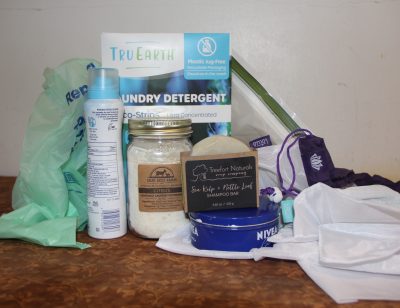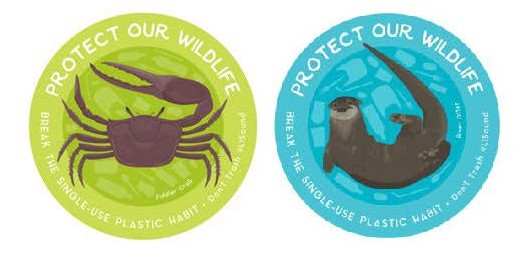
By Judy Benson
Trying to give up single-use plastics can seem like a fool’s errand, with nearly every imaginable product you can buy ensconced in plastic packaging.
“We live in a society that’s completely skewed towards single-use plastics,” said Gaboury Benoit, professor in the Yale School of the Environment who’s researching trash habits in New Haven.
A few of us at Connecticut Sea Grant decided to try anyway for a week last month, as part of the international Plastic-Free July initiative.
It was a way to prepare for the eighth annual #DontTrashLISound campaign with N.Y. Sea Grant. It will kick off Aug. 17 with a cleanup at Hammonassett Beach State Park co-sponsored with Save the Sound, and continue through International Coastal Cleanup Day Sept. 21 with social media posts, beach cleanups and giveaways of “Protect Our Wildlife” stickers. By sharing what we learned this week, we hope to help others to be more mindful of their own trash habits, especially when it comes to plastic, only about 9 percent of which is recycled. After all, the most effective way to reduce the amount of trash getting into Long Island Sound is for all of us to generate less in the first place.
Plastic-Free July began in Australia in 2011, and since then has inspired millions to take small steps to avoid throwaway plastic, hoping to build global momentum to stop the flood of plastic waste polluting our waterways and land, harming humans and wildlife in the process. But, as anyone who’s tried this knows, success is limited.
“It was a good exercise,” said Owen Placido, CTSG assistant extension educator for nature-based resiliency. “It was eye opening when I asked myself if I really needed to buy plastic bottles of water and soda and decided to cut it out. But there’s some stuff like mouthwash you can only find in plastic.”
Eliminating single-use plastic altogether was impossible, he and the rest of us discovered. Whole categories of products including meats, cheeses and most breads can only be purchased in plastic.
CTSG Research Coordinator Syma Ebbin has long been conscientious about using less plastic. That week she used her own wine glass at an art museum event instead of the plastic ones offered. But when she tried looking for new ways to avoid plastic at the grocery store, she was frustrated.
“I became aware of where I couldn’t do it,” she said.
Associate Director Nancy Balcom, one of the leaders of the Long Island Sound Marine Debris Action Plan, made sure she had reusable produce bags at the grocery store, and found plant-based biodegradable sandwich bags and composable garbage bags. I found anti-perspirant and body lotion in recyclable cans, a shampoo bar and detergent sheets packaged in a small cardboard envelope.
Without the plastic fast, we wouldn’t have discovered these products. But while we were encouraged to find them, these are the exceptions. We were left wondering whether consumers need to start letting manufacturers know we want them to ditch the plastic. How about selling individual yogurt cups and cottage cheese in heavy waxed cardboard cups like they once were? How about wrapping deli meat and cheese in heavy paper and skipping the plastic wrapper? Consider how much more widely available organic products have become in recent years, as consumers conveyed their preferences with their wallets.
But even that isn’t enough. Benoit thinks that ultimately, producers need to be held accountable for reducing plastic.
“What should happen is there should be extended producer responsibility,” he said. “So many plastic products we can do without.”
Judy Benson is the communications coordinator of Connecticut Sea Grant.
